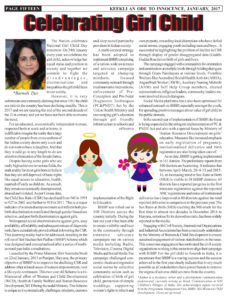 Barnali Das
Barnali Das
The Nation celebrates National Girl Child Day tomorrow. On 24th January every year, we celebrate the girl child, acknowledge her equal status and position in society and together we commit to fight the disadvantages, discriminations and inequalities the girl child faces in our society.
However, it is very unfortunate and extremely alarming that since 1961 the child sex ratio in the country has been declining steadily. This is 2017 and we are nearing the end of the second decade of the 21st century and yet we have not been able to reverse the trend.
For an educated, economically independent woman, respected both at work and at home, it is difficult to imagine the reality that a large number of people from cross sections of the Indian society desire only a son and do not wish to have a daughter. And that they would go to any length to do sex selective elimination of the female foetus.
Despite having some girls who are really high achievers in various fields, the stark reality for most girls born in India is that they are still deprived of basic rights like equal access to education, health, married off early as child etc. As a result, they remain economically disempowered, abused and violated. As per Census data, the Child Sex Ratio (CSR) has declined from 945 in 1991 to 927 in 2001 and further to 918 in 2011. This is a major indicator of women disempowerment as it reflects both pre-birth discrimination manifested through gender biased sex selection, and post birth discrimination against girls.
Widespread social discriminations against girls, easy availability, affordability and subsequent misuse of diagnostic tools, have cumulatively proved critical in lowering the CSR. This alarming reality had to be addressed, resulting in the roll out of Beti Bachao Beti Padhao (BBBP) Scheme which was designed and conceptualized after a series of multi-sectoral pan India consultations.
Launched by the Prime Minister, Shri Narendra Modi on 22nd January, 2015 at Panipat, Haryana, the primary objective of BBBP is to improve the declining CSR and address other related issues of women empowerment, over a life-cycle continuum. This two year old Scheme is a tri-Ministerial effort of Women and Child Development (WCD), Health & Family Welfare and Human Resource Development; WCD being the nodal Ministry. This Scheme is unique as it systematically challenges mindsets, customs and deep rooted patriarchy prevalent in Indian society.
A multi-sectoral strategy has been adopted to implement BBBP, comprising of a nation-wide awareness and advocacy campaign targeted at changing mindsets, focused community outreach through local innovative interventions; enforcement of Pre-Conception and Pre-Natal Diagnostic Techniques (PC&PNDT) Act by the Union Health Ministry and encouraging girl’s education through girl friendly infrastructure in schools and effective implementation of the Right to Education.
BBBP was rolled out in 100 Districts across the country initially. During the last one year it has been able to create visibility and buzz in the community through extensive advocacy campaigns run on various media including Radio, Television, Cinema, Digital Media and Social Media The campaign challenged son-centric rituals and regressive social norms by collective community action such as celebration of birth of girl child, promotion of simple weddings, supporting women’s rights to inherit and own property, rewarding local champions who have defied social norms, engaging youth including men and boys. . It succeeded in highlighting the problem of decline in CSR through display of gender disaggregated data (Guddi-Gudda Boards) on birth of girls and boys.
The campaign engaged with communities for orientation and sensitization at multiple levels through holding dialogues through Gram Panchayats at various levels. Frontline Workers like Accredited Social Health Activist (ASHA), AnganWadi Worker (AWW), Auxiliary Nursing Midwife (ANM) and Self Help Group members, elected representatives, religious leaders, community leaders etc. were involved in such dialogues.
Social Media platforms have also been optimised for enhanced outreach on BBBP, especially amongst the youth, for spreading positive messages about value of girl child in the public domain.
In the second year of implementation of BBBP, the focus is being expanded to the stringent implementation of PC & PNDT Act and also with a special focus by Ministry of Human Resource Development on girls’ education. Measures like increased emphasis on early registration of pregnancy, institutionalised deliveries and birth registration are also being taken care of.
As on date, BBBP is getting implemented in 161 districts. The preliminary reports from 100 districts are heartening. It indicates that between April-March, 2014-15 and 2015-16, an increasing trend in Sex Ratio at Birth (SRB) is visible in 58 BBBP districts; 69 districts have reported progress in the first trimester registration against the reported ANC registrations and status of institutional deliveries have improved in 80 districts against the total reported deliveries in comparison to the previous year. The Sex Ratio at Birth (SRB) touching the 900-mark for the first time in almost two decades in December 2016 in Haryana, notorious for its skewed sex ratio, has been widely reported in the media.
Engaging with Civil Society, International Organizations and Industrial Associations has been consciously undertaken by the Ministry of Women & Child Development to ensure sustained engagement of various stakeholders on the issue. This conscious engagement has motivated the civil society organizations working in this sector to re-align their campaign with BBBP. For the girl child to flourish in India, it is paramount that BBBP is a roaring success and the success achieved in the first year clearly indicate that it very much possible as all stakeholders have joined hands to remove the stigma of adverse child sex ratio from the country.
(Author is a freelance writer and a development communication professional, currently serving as Head, Communication at SOS Children’s Villages of India. She acknowledges inputs received from the Programme Management Unit, BBBP, M/o Women & Child Development. Views are personal.)





